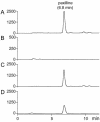Indole-diterpene gene cluster from Aspergillus flavus
- PMID: 15528556
- PMCID: PMC525135
- DOI: 10.1128/AEM.70.11.6875-6883.2004
Indole-diterpene gene cluster from Aspergillus flavus
Abstract
Aflatrem is a potent tremorgenic mycotoxin produced by the soil fungus Aspergillus flavus and is a member of a large structurally diverse group of secondary metabolites known as indole-diterpenes. By using degenerate primers for conserved domains of fungal geranylgeranyl diphosphate synthases, we cloned two genes, atmG and ggsA (an apparent pseudogene), from A. flavus. Adjacent to atmG are two other genes, atmC and atmM. These three genes have 64 to 70% amino acid sequence similarity and conserved synteny with a cluster of orthologous genes, paxG, paxC, and paxM, from Penicillium paxilli which are required for indole-diterpene biosynthesis. atmG, atmC, and atmM are coordinately expressed, with transcript levels dramatically increasing at the onset of aflatrem biosynthesis. A genomic copy of atmM can complement a paxM deletion mutant of P. paxilli, demonstrating that atmM is a functional homolog of paxM. Thus, atmG, atmC, and atmM are necessary, but not sufficient, for aflatrem biosynthesis by A. flavus. This provides the first genetic evidence for the biosynthetic pathway of aflatrem in A. flavus.
Figures






References
-
- Altschul, S. F., W. Gish, W. Miller, E. W. Myers, and D. J. Lipman. 1990. Basic local alignment search tool. J. Mol. Biol. 215:403-410. - PubMed
-
- Aramori, I., M. Fukagawa, M. Tsumura, M. Iwami, H. Ono, H. Kojo, M. Kohsaka, Y. Ueda, and H. Imanaka. 1991. Cloning and nucleotide sequencing of a novel 7-beta-(4-carboxybutanamido) cephalosporanic acid acylase gene of Bacillus laterosporus and its expression in Escherichia coli and Bacillus subtilis. J. Bacteriol. 173:7848-7855. - PMC - PubMed
-
- Bennett, J. W., and L. L. Lasure. 1985. Conventions for gene symbols, p. 537-544. In J. W. Bennett and L. L. Lasure (ed.), Gene manipulation in fungi. Academic Press, London, United Kingdom.
-
- Bullock, W. O., J. M. Fernandez, and J. M. Short. 1987. XL1-Blue: a high efficiency plasmid transforming recA Escherichia coli strain with beta-galactosidase selection. BioTechniques 5:376-378.
Publication types
MeSH terms
Substances
Associated data
- Actions
- Actions
- Actions
LinkOut - more resources
Full Text Sources

